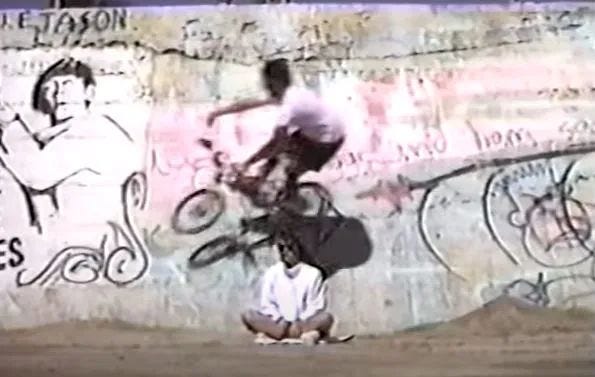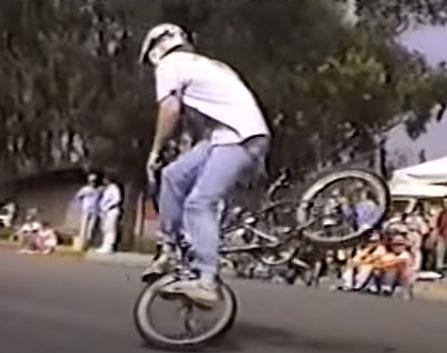BMX is DEAD! Long live BMX- The 2020's are the new 1990's
GT pro freestyler in the 1980’s, Josh White, stretching a one footed lookdown at Edison High School trails in Huntington Beach. This is a video still from 1990, and I think Josh’s pro GT sponsorship was over at that point. He was riding for fun. But progression continued in BMX, after the sport was declared “dead.” I had never seen this variation on dirt before, and Josh was best known as a vert rider, not a dirt jumper. As I write this, GT Bikes “paused” operations last month, January 2025, most people seem to believe they’re permanently out of business as a company. #steveemigphotos
I just learned that BMX is dead… again. I stumbled on this video online yesterday, which shows a young rider and video producer, Brant Moore (@Brant_Moore on IG) doing a quick interview with 1980’s Skyway pro freestyler, and pioneering BMX video producer, Eddie Roman. One of Brant’s friends told him to watch the intro to Eddie’s epic 1992 video, Ride On. Take a minute and watch the first minute or two. Eddie explains in the intro that bike sales had dropped off, most of the factory teams had dropped their riders, and some had given up on BMX and freestyle altogether. The overall bike industry had told us that BMX had died. That was in 1992. Apparently 2025 looks similar to today’s young riders.
Those of us who had devoted most of our time in the 1980’s to learning tricks on BMX bikes, collectively building the first wave of BMX freestyle, weren’t sure what to do when BMX “died” in 1989. Except to keep riding. BMX didn’t actually die, it went underground. The funny thing was, the progression of riding itself actually seemed to increase. The posers and the money in BMX freestyle were virtually all gone. But the small number of riders that kept riding pushed the level higher and higher during the five or six down years.
That’s me (Steve Emig) with a wall ride on the Blues Brothers Wall, over my sister Cheri’s head. This is another video still from 1990, also from The Ultimate Weekend video. My sister was visiting on Spring Break from college in NorCal, and I was still working at Vision Skateboards, as the one guy left in the video department, which had been its own company, with seven employees, a couple of months earlier. BMX had already died, and skateboarding was going down fast as well, when I shot this video. #steveemigphotos
For BMX, there was one weekend when it happened, taking us all by surprise. In January of 1989, the big bike industry trade show was in Long Beach. Walking through it, I literally heard it in booth after booth. Salesmen, company owners and other industry guys were saying it all day. “BMX is dead. Mountain bikes are the new thing.” A bunch of us BMX freestylers were there, some guys were riding in the freestyle demos, representing their sponsors. There were also some of us rider/industry guys, walking around, picking up free stickers for our collections, and talking to both riders and industry people. As riders, BMX didn’t feel dead. It was changing fast, rolling tricks had taken over flatland, the first major street riding contest had taken place less than a year earlier, and the motocross-style leathers as uniforms were fading from popularity. BMX freestyle was finding its own voice and identity. How could the thing we’d dedicated 4 to 7 years of our lives to be dead?
But that’s what the bike industry as a whole had decided in January of 1989. The motherfuckers didn’t bother to ask any of us riders. They just pronounced BMX racing and freestyle “dead,” and started pulling money out of the sports. By the Brooklyn Banks 2-Hip Meet the Street contest in August of 1989, all the factory teams were gone, except Haro and GT, who kept their core touring pros. At the Brooklyn Banks comp, even Mat Hoffman and Dennis McCoy didn’t have sponsors. I was there in Manhattan as a cameraman for Vision, but rode in the contest as well. That turned out to be the single most fun weekend of my BMX years. The pro purse was maybe $200 for first place, something like that. It was a totally D.I.Y. contest at a real street spot, street riding was brand new as a contest sport, and that weekend was epic.
The big money, much of it from outside the BMX and bike industry, that’s what causes the waves or cycles in BMX and most other action sports. The sports grow on their own for a while. Media coverage expands, a new crop of young riders (or skaters, boarders, surfers, etc.) get drawn into the sport. Word gets around in business and marketing that the sport is “the cool new thing.” That’s when money from outside the sport comes in, to take advantage of the current hype to help sell their soda, potato chips, shoes, sunglasses, energy drinks, beef jerky, cars, whatever. Their attention draws more attention, the sport “explodes,” with money and hype sloshing around for two or three years, maybe more.
Then something else becomes the hot new thing, both in sports, and to promote products. The big money starts to pull out, often there’s a financial recession in the mix as well. Bike sales drop. The large bike companies, who aren’t hardcore BMX people, see sales drop in BMX bikes. They pull back, providing even less financial support, media coverage, and advertising. Riders get dropped by sponsors. Someone declares BMX (or skateboarding, surfing, snowboarding, whatever) “dead.” The industry money pulls out. Things go underground. The hardcore riders or skaters keep riding and skating. Progression continues. D.I.Y., low money comps and events happen.
Eventually the sport gets “discovered’ again, in 3-4-5 years. In our case, after the lean years of the early 1990’s, ESPN “discovered” action sports, labeled them “extreme”, and used our sports, to launch ESPN 2, their second cable TV sports channel. When that kind of thing happens, whatever decade, the new boom or cycle begins.
Huntington Beach local flatlander, Andy Mulcahy, scuffing one out at a contest in the Rose Bowl parking lot, in the spring of 1990. Andy was one of the young guys totally into flatland in 1990, hitting his prime as BMX and BMX freestyle “died.” Another video still from The Ultimate Weekend. #steveemigphotos
So what happened in BMX during the long recession of the early 1990’s? We all learned how to live cheap and make several different types of meals out of a pack of ramen. We piled into houses, sharing rooms at times, to keep costs down. We lived off of 49 cent tacos at Del Taco and 59 cent tacos at Taco Bell. And we kept riding and progressing. The punk rock/DIY (Do It Yourself) spirit took over. Some riders started small bike companies, S&M Bikes started in 1987, but Chris Moeller bought out his partner and really got serious around 1989-1990. Hoffman, Wilkerson Airlines, Eastern, Standard, and FBM bike companies all started in those years. Ron Wilkerson was kept putting on 2-Hip contests, and Mat Hoffman, Steve Swope and their posse started putting on the CFB comps. A handful of local trick teams kept making money doing school shows in their regions. Eddie Roman, Mark Eaton, Jeremy Alder, and myself started self-producing our own BMX videos in 1989-1990, as S-VHS and Hi-8 cameras became more affordable. Many others followed a couple of years later, making dozens more indie BMX (and skate and snowboard) videos. Props Video Magazine started around 1993, I think. Brad McDonald started Ride magazine in the U.S. and Will Smyth started Dig BMX in the U.K.. A whole bunch of small clothing and parts companies were born during the “dead” period.
Actual riders took over the BMX industry, that’s what happened after BMX “died,” in the early 1990’s. Skaters, most notably Steve Rocco and World Industries, took over skateboarding at the same time. The same thing happened in snowboarding, though it was just taking off in popularity then.
The down times, the lean years when action sports go underground, serve a purpose. We seem to be entering a similar period now. In the bigger economic picture, heading into a serious recession, which will slow down business in most industries over the next few years. That’s on top of all the business chaos caused by the pandemic, supply shocks, and the current political nightmare we are watching unfold. During the lean times in action sports, the hardcore people remember why they really do these sports, day after day. The bloated, out-of-touch, and overly corporate companies often change focus to new trends, or just die off. There’s a death and rebirth period, like the mythical phoenix. New ideas, new styles of riding, new businesses, and new themes are born and begin growing.
Now, in early 2025, I’m an out-of-the-loop old geezer who got pushed away from BMX and action sports in the early 2000’s. But I’m a writer, a long term thinker, and a guy who keeps his eye on the long term economic and social trends playing out. I’m writing this post to tell you, I’ve seen this scenario before, all the Old School BMXers have, and it was really tough for us in 1989, 1990, and into 1991. But we figured it out back then, in a tiny sport, with virtually no money. Now there are a bunch of Old School riders around, long term rider/industry people, and other experienced ones, to help the younger people make sense, and make the most of the lean years.
Now you have an idea what’s happening, and the opportunities the tough times, the lean years, bring. Keep riding and go out and create some really cool shit. Ride on.
There are no paid links in this post.







